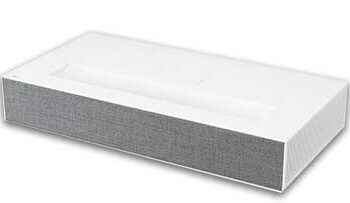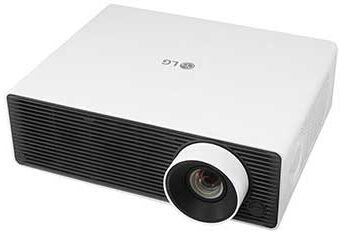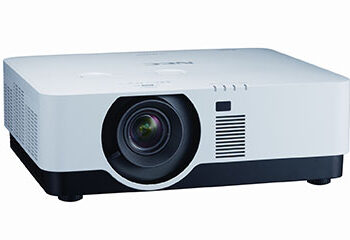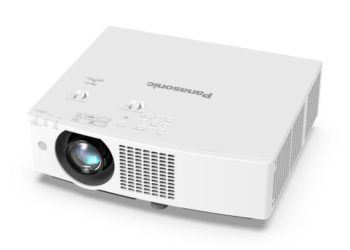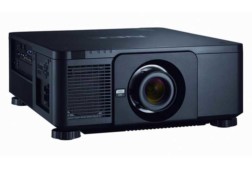Welcome to Our Annual Education Projector Buyer’s Guide
This Education Projector Buyer’s Guide explores a wide range of projectors made for K-12 schools, colleges, and museums. When selecting the best models, we focus on how they perform in real classrooms and learning spaces.
The last few years have transformed education. COVID-19 pushed teachers to find new ways to connect with students both in person and online. Many schools and museums turned to virtual learning, and technology use grew quickly. Interactive projectors became popular because they let students at home and in class see the same content at the same time.
Today, most students are back in classrooms. However, the pandemic still shapes how schools use technology. One clear result is that teachers and students now feel more comfortable with digital tools.
As schools adapt, projectors play a key role. They provide large images that help with social distancing. For K-12, a screen of 90 inches or larger is best. For college lecture halls, a 100-inch screen or more works well. Smaller displays, such as 60 inches, are not practical in big classrooms. For more details, see our guide to the “Equivalent Visibility Rule.”
Why Education Projectors Matter
This guide highlights three main categories of projectors:
Standard Projectors – Affordable models, ideal for K-12 classrooms with tight budgets.
Large Venue Projectors – Designed for big lecture halls, auditoriums, or multi-purpose rooms.
High-End Projectors – Built for digital displays and projection mapping, often used in museums or exhibitions.
Many projectors also include short-throw or ultra-short-throw lenses, making them easier to install. Some models feature lens shift or interchangeable lenses, which add flexibility but also affect cost. Interactivity is another growing trend, making lessons more engaging and collaborative.
Inside This Year’s Education Projector Guide
We reviewed dozens of projectors and selected about 20 of the best for education. Each model comes with a summary and a link to a full review. These 20 projectors represent nearly 100 options currently on the market.
Some models return from last year’s list. Projectors usually remain in production for two to four years, so strong performers stay relevant. We highlight repeat award winners and also showcase the newest standouts.
As schools prepare for upgrades and the next academic year, we aim to make the decision process easier. We select projectors that provide excellent value, strong performance, and practical features for education.
FEATURES TO CONSIDER WHEN CHOOSING AN EDUCATION PROJECTOR

How to Choose a Projector for Education
What Are Your Installation Needs?
Think carefully about where and how to install the projector:
Placement location
Ease of maintenance
Expected lifespan
Inputs and controls
Modern features include laser light sources, lens shift, interchangeable lenses, keystone correction, image blending, and remote monitoring. Choosing the right Education Projector makes installation and long-term use much easier.
What Presentation Tools Do You Need?
Your teaching style determines the tools you need:
Interactivity for group work
Wireless sharing for easy access
Special display modes for different subjects
Standard Projectors for K-12 Classrooms are compact and reliable. They often include wireless options, advanced networking, collaboration tools, and PC-free presenting. These features make them ideal for everyday teaching.
The main role of a K-12 Education Projector is to display presentations and learning materials clearly. Choosing the right model depends on classroom lighting and the specific features your school needs.
Final Thoughts
An Education Projector is more than a display tool—it supports interactive, engaging, and effective learning. By matching brightness, resolution, installation, and features to your classroom, you can create the best environment for students.
EPSON BRIGHTLINK 1485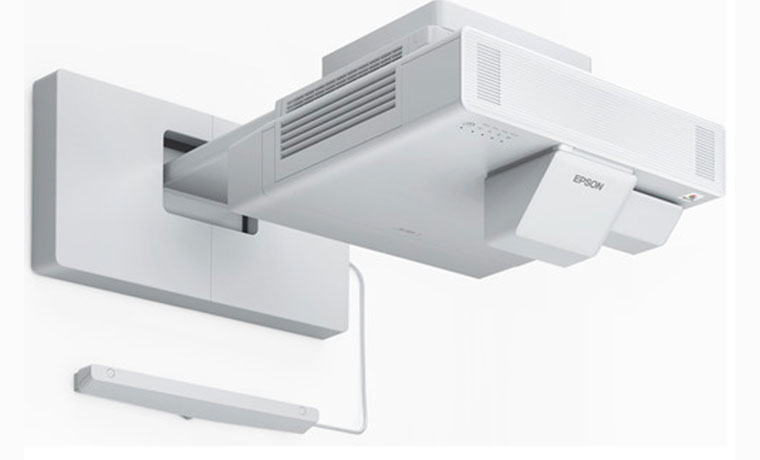
Epson BrightLink 1485Fi Education Projector Review
The Epson BrightLink 1485Fi Education Projector is designed for interactive learning and collaboration. With advanced features, it creates a flexible classroom or meeting environment where teamwork is simple and effective.
Epson BrightLink 1485Fi Specs
Price: $3,390
Technology: Solid State Laser Diode
Native Resolution: 1920 × 1080 (Full HD)
Brightness: 5,000 lumens
Contrast Ratio: 25,000:1
Zoom: 1.35x digital zoom
Lens Shift: No
Lamp Life: 20,000 hours
Weight: 14.77 lbs
For a complete guide to choosing brightness levels, check our Education Projector Buyer’s Guide.
Award-Winning Collaboration
The Epson BrightLink 1485Fi received a Special Interest Award for its interactive design. Up to eight users can write on the screen at the same time, even from different locations. With Epson’s iProjection software, up to 50 participants can connect and share content. This makes teamwork easy in both classrooms and remote learning environments.
Projector Overview
This Education Projector delivers native 1080p resolution using Epson’s 3LCD laser display. With 5,000 lumens of brightness, it works in classrooms with strong lighting. The laser light source lasts 20,000 hours and requires no lamps or frequent maintenance.
The projector can show a 100-inch 16:9 image or a 120-inch 16:6 image, which fits perfectly with most classroom boards. Compared to a 75-inch flat panel, the Epson 1485Fi offers nearly twice the interactive space.
Key Features
1. Built for Collaboration
Up to eight users can write, draw, or annotate together. This makes group projects and classroom discussions more interactive.
2. Epson iProjection Software
The iProjection app allows up to 50 local or remote participants to join. The host can control who presents, share content from four devices at once, and pause the screen for feedback.
3. Touch and Pen Support
Students and teachers can use either their fingers or Epson pens. It feels as natural as writing on a tablet or smartphone.
4. Miracast Wireless Sharing
Built-in Miracast lets you stream videos, images, and presentations directly from laptops, tablets, or phones—even without Wi-Fi.
Why Choose the Epson 1485Fi?
The Epson BrightLink 1485Fi Education Projector is more than a display—it is a hub for interactive learning. It supports teamwork in classrooms, offices, and remote learning setups.
If you want to compare it with other models, see our review of the BenQ LH930 Education Projector.
Final Thoughts
The Epson 1485Fi is a smart choice for schools and businesses looking to improve collaboration. With strong specs, long life, and advanced software, it stands out as one of the best Education Projectors on the market today.
PANASONIC PT-LRZ35U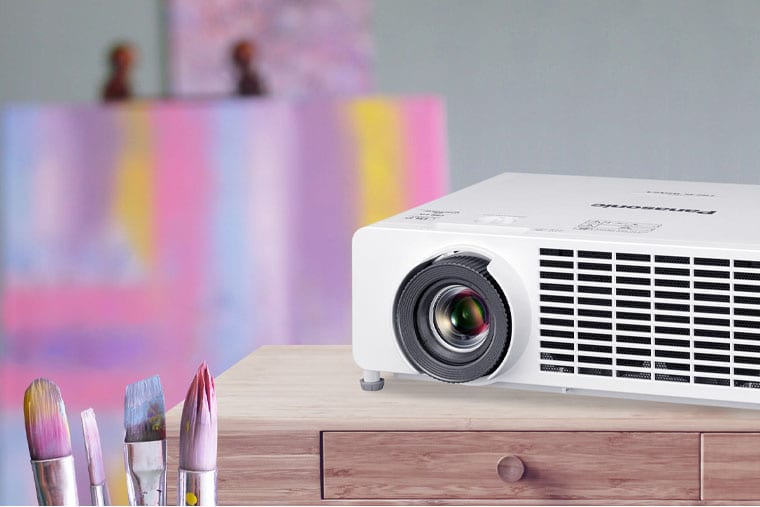
Panasonic PT-LRZ35U Education Projector Review
The Panasonic PT-LRZ35U Education Projector is a portable RGB LED model that delivers strong color performance, flexible installation, and long life. It works well in classrooms, meeting spaces, and even home environments where accurate color is important.
Panasonic PT-LRZ35U Specs
Price: $2,999 MSRP / $1,699 average street price
Technology: RGB LED DLP
Native Resolution: 1920 × 1200 (WUXGA)
Brightness: 3,500 lumens
Contrast Ratio: 35,000:1
Zoom Lens: 1.3x manual zoom
Lens Shift: Vertical shift available
Lamp Life: 20,000 hours (LED)
Weight: 14.77 lbs
If you are still deciding how much brightness you need, check our Education Projector Buyer’s Guide.
Projector Overview
The PT-LRZ35U is Panasonic’s first portable projector to use a discrete RGB LED light engine. By separating red, green, and blue LEDs, it delivers more natural and accurate color than many competing models. With a WUXGA resolution (1920 × 1200) and 3,500 lumens, it fits both education and business environments.
Although its official price is $2,999, many retailers list it closer to $1,699, making it a strong value option compared with other business and classroom projectors.
Key Features
1. RGB LED Light Engine
The PT-LRZ35U uses separate red, green, and blue LEDs to create richer colors. The LED design lasts up to 20,000 hours without bulb changes or filters, reducing maintenance.
2. Flexible Installation
You can mount this projector in almost any way. It tilts, rolls, and even supports portrait mode. A 1.3x zoom and manual vertical lens shift give more control over placement.
3. Connectivity and Network Control
Dual HDMI ports, a DIGITAL LINK/LAN (HDBaseT) port, and USB power support for streaming sticks make it versatile. Built-in Ethernet allows remote management, scheduling, and maintenance alerts.
4. PJLink Support
With PJLink, schools and businesses can control the PT-LRZ35U along with projectors from other brands in one system.
Why Choose the PT-LRZ35U as an Education Projector?
For classrooms, museums, and meeting rooms, this projector combines bright output and long life with reliable color reproduction. Teachers and IT managers will also appreciate its low maintenance design and flexible installation options.
To compare with another award-winning classroom model, read our review of the Epson BrightLink 1485Fi Education Projector.
For official product details, visit the Panasonic PT-LRZ35U page.
Final Thoughts
The Panasonic PT-LRZ35U Education Projector offers high color accuracy, solid brightness, and excellent value for its price. With its LED engine, remote management features, and flexible mounting, it is a strong choice for schools and businesses that need a reliable, long-lasting projection solution.
LG HU85LS
LG HU85LS Education Projector Review
The LG HU85LS Education Projector is a 4K ultra-short throw laser model designed for classrooms, offices, and home theaters. With its compact design, sharp image quality, and smart features, it can replace large flat panels in modern learning spaces.
LG HU85LS Specs
Price: $5,999
Technology: DLP (0.66” DMD)
Native Resolution: 2716 × 1528 × 2 (pixel shifting)
Brightness: 2,700 lumens
Contrast Ratio: 2,000,000:1
Zoom Lens: None
Lens Shift: No
Lamp Life: 20,000 hours
Weight: 26 lbs
Warranty: 2 years
For schools comparing different brightness levels, see our Education Projector Buyer’s Guide.
Projector Overview
The LG HU85LS is a 4K ultra-short throw Education Projector that sits just 8 inches from the screen. It creates images up to 120 inches while saving space, making it an excellent option for classrooms and meeting rooms. The laser light source lasts 20,000 hours, reducing the need for lamp replacements.
Its 0.66” DLP chip uses pixel shifting to deliver a clear, sharp image. Combined with a 2,000,000:1 contrast ratio, the projector produces bright and vivid visuals that enhance both education and entertainment.
Key Features
1. Laser Light Engine
The HU85LS uses triple laser technology (red, blue, and a blue-phosphor green) to produce a wide color range with minimal rainbow effect. It also offers multiple brightness modes for flexible use.
2. 4K Pixel Shifting
With a large DLP chip, the HU85LS shifts pixels quickly to deliver a detailed 4K image. Unlike some models, it avoids alignment issues, making it reliable for both teaching and presentations.
3. Smart TV Functions
Running LG’s webOS platform, this projector supports apps, wireless streaming, and Google Assistant voice control. It also includes a built-in TV tuner, making it a versatile solution for schools and homes.
4. HDR10 with Dynamic Tone Mapping
The projector adjusts brightness and color in real time, improving HDR playback for both movies and presentations.
5. HDMI ARC and Audio Support
With HDMI ARC, the projector connects easily to sound systems. It supports Dolby Atmos (compressed), which adds depth to presentations and videos.
Why Choose the LG HU85LS as an Education Projector?
The HU85LS combines short throw design, long-lasting laser light, and smart features in one package. For schools, it offers a large image without needing extra space. Teachers can use built-in apps and wireless sharing to enhance lessons. For businesses, it provides reliable performance with modern connectivity.
If you want to compare other models, check our Epson BrightLink 1485Fi Review or BenQ LH930 Education Projector Review.
For full details, visit the LG official HU85LS page.
Final Thoughts
The LG HU85LS Education Projector offers big-screen performance in a compact form. Its ultra-short throw design, triple laser light engine, and smart TV features make it a strong choice for schools and businesses that need reliable, high-quality projection.
ViewSonic M2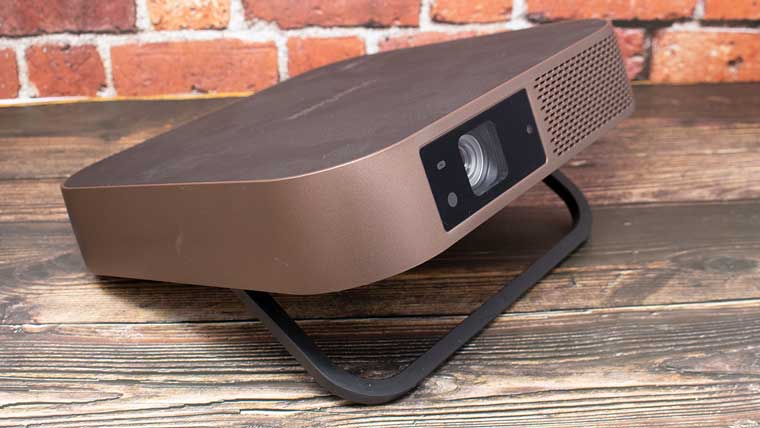
ViewSonic M2 Education Projector Review
The ViewSonic M2 Education Projector is a portable Full HD model that combines sharp visuals, long-lasting LED technology, and built-in Harman Kardon speakers. Its small size makes it easy to carry between classrooms, offices, or even dorms. With smart features and strong audio, it’s a practical choice for both teaching and entertainment.
ViewSonic M2 Specs
Price: $549.99
Technology: DLP LED
Native Resolution: 1920 × 1080 (Full HD)
Brightness: 500 ANSI lumens (~1200 LED lumens)
Contrast Ratio: 3,000,000:1
Zoom Lens: Fixed
Lens Shift: No
Lamp Life: Up to 30,000 hours
Weight: 2.9 lbs
Warranty: 3 years limited
For brightness comparisons, check our Education Projector Buyer’s Guide.
Projector Overview
The ViewSonic M2 Education Projector is designed for portability. It projects a 100-inch image from less than 9 feet away, which makes it ideal for small classrooms or meeting spaces. Its LED light engine lasts up to 30,000 hours, reducing maintenance costs and eliminating lamp replacements.
Key Features
1. LED Light Source
The M2 delivers 500 ANSI lumens of brightness (around 1200 LED lumens). It also covers 125% of the Rec.709 color range, producing vivid and accurate images. For schools, this means presentations look sharp and engaging.
2. Harman Kardon Speakers
Dual 3-watt Harman Kardon speakers provide clear and room-filling sound. While bass is light, voices and details sound crisp—ideal for both lectures and video lessons.
3. Smart Features
The M2 comes with its own app store, supporting Netflix, YouTube, and other streaming apps. With Alexa and Google Assistant voice control, teachers can launch apps or adjust settings hands-free. Built-in Wi-Fi (via dongle) adds flexibility for presentations and streaming.
4. Media Player and Storage
With 16GB internal memory (10GB usable), the M2 stores documents and media files directly. It also supports playback from USB drives, making it easy to present without a laptop.
5. Eye Protection Mode
A safety feature turns off the light automatically if someone gets too close, protecting students’ eyes during use.
Why Choose the ViewSonic M2 as an Education Projector?
The M2 combines portability, smart features, and built-in audio in a compact package. For teachers, it reduces setup time and makes presentations more interactive. For students, it creates a comfortable viewing and listening experience.
If you want to compare other options, check our BenQ LH930 Education Projector Review or Epson BrightLink 696Ui Review.
For full technical details, visit the ViewSonic official M2 page.
Final Thoughts
The ViewSonic M2 Education Projector is a strong choice for schools and small spaces. With its LED engine, smart apps, and built-in Harman Kardon audio, it brings reliable performance to modern classrooms and offices.
ViewSonic LS625W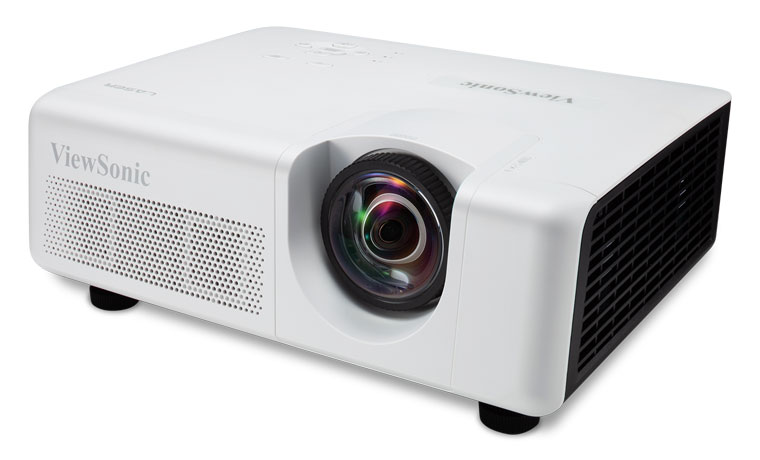
ViewSonic LS625W Education Projector Review
The ViewSonic LS625W Education Projector is a short-throw model built for classrooms and offices. It combines a bright laser light engine, interactive tools, and compact design. With a projection distance of just 2.6 to 3.7 feet, teachers can create a large screen image without shadows or glare.
ViewSonic LS625W Specs
Price: $1,438.99
Technology: DLP
Native Resolution: 1280 × 800 (WXGA)
Brightness: 3,200 ANSI lumens
Contrast Ratio: 100,000:1
Zoom Lens: No
Lens Shift: No
Lamp Life: 20,000 hours
Weight: 13.7 lbs
Warranty: 3 years
For comparisons, check our Education Projector Buyer’s Guide.
Projector Overview
The LS625W delivers clear and bright visuals with its 3,200-lumen laser light source. It supports resolutions up to 1920 × 1200, so it works well with a wide range of devices. Its compact design makes it easy to install in classrooms where space is limited.
Key Features
1. Laser and DLP Technology
The LS625W combines laser and phosphor light with DLP imaging for sharp pictures. The dynamic contrast ratio of 3,000,000:1 improves black levels, making images look richer and more detailed.
2. Short Throw Design
This model can project a 70–100 inch image from less than 4 feet away. Teachers can stand near the screen without casting shadows, which improves visibility for all students.
3. Built-in Speakers
With two 10-watt speakers, the LS625W produces sound that is clear enough for most classrooms. For larger lecture halls, external speakers may still be needed.
4. Interactive Whiteboard Support
The LS625W works with ViewSonic’s interactive whiteboard module, letting up to 10 users draw or write directly on the screen. Teachers can record lessons and share notes digitally, making classes more engaging.
Why Choose the ViewSonic LS625W as an Education Projector?
This projector offers strong performance for schools that want bright visuals, modern widescreen resolution, and interactive tools. Its short-throw lens makes it easy to install in classrooms with limited space, while its laser engine reduces long-term maintenance.
To explore more options, see our BenQ LH930 Education Projector Review or Epson BrightLink 696Ui Review.
For official specifications, visit the ViewSonic LS625W page.
Final Thoughts
The ViewSonic LS625W Education Projector is a reliable choice for schools and small offices. With its bright laser source, interactive features, and short throw design, it helps teachers deliver dynamic lessons in modern classrooms.
BENQ EW800ST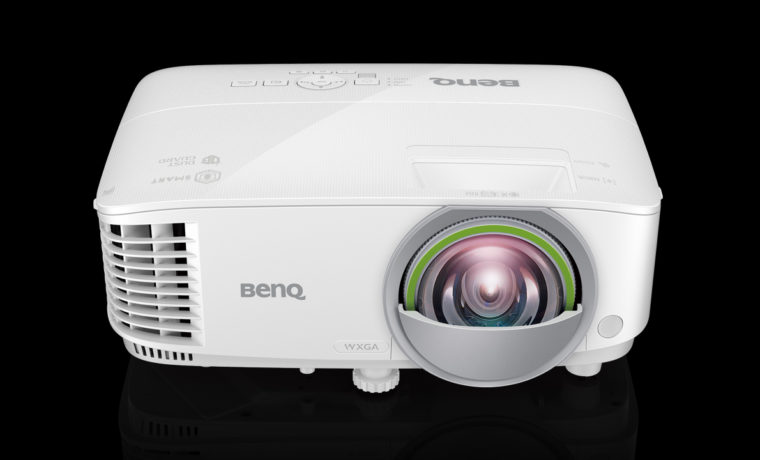
BenQ EW800ST Education Projector Review
The BenQ EW800ST Education Projector is a smart short-throw model designed for classrooms, meetings, and small conference rooms. With WXGA resolution and 3,300 lumens brightness, it delivers clear and bright visuals. Teachers will find its smart tools helpful for managing lessons more efficiently, both online and in person.
BenQ EW800ST Specs
Price: $999
Resolution: WXGA (1280 × 800)
Technology: DLP
Brightness: 3,300 lumens (up to 4,445 in brightest mode)
Light Source: Lamp
Lamp Life: 5,000 hours (normal) / 10,000 hours (eco)
Weight: 6 lbs
Warranty: 3 years parts and labor
For more comparisons, see our Education Projector Buyer’s Guide.
Projector Overview
The EW800ST combines compact size with smart features. It doesn’t include touch or pen interactivity like some models, but it supports cloud storage, mobile control, and strong connectivity. Its short-throw design allows it to project large images from close range, making it a good fit for small classrooms.
Key Features
1. Smart Teaching Tools
Teachers can access personal cloud storage with a BenQ AMS account, keeping lessons organized and easy to share. The BenQ Smart Control App also turns smartphones or tablets into projectors’ remote controllers.
2. Wireless Connectivity
The EW800ST includes a Wi-Fi and Bluetooth dongle, so teachers can connect wirelessly to laptops, tablets, or smartphones without hassle.
3. Classroom-Friendly Short Throw
This projector creates a large screen from a short distance and can be wall-mounted above the screen. This setup reduces shadows and improves visibility for students.
4. Versatile Connections
It features HDMI, 3 USB ports, computer input, audio out, and a serial control port, giving teachers flexibility to connect different devices.
5. Built-in Audio
With its 2-watt speaker, the EW800ST delivers enough sound for most classrooms. For larger rooms, external speakers can be connected via audio out or Bluetooth.
6. Network and Management
It supports Crestron RoomView for LAN-based network control. Combined with wireless management, this makes it easy for schools to manage multiple projectors.
Why Choose the BenQ EW800ST Education Projector?
The BenQ EW800ST is an affordable choice for schools that need smart features without paying for higher-end interactive models. Its short-throw lens, wireless connectivity, and lesson management tools make it perfect for teachers.
For other options, check our BenQ LH930 Education Projector Review or the Epson Brightlink 1485Fi Review.
For official specs, visit the BenQ EW800ST page.
Final Thoughts
The BenQ EW800ST Education Projector balances price and performance. With smart apps, wireless access, and flexible installation, it helps teachers make lessons smoother and more interactive. For schools on a budget, this projector is a solid investment.
EPSON POWERLITE U50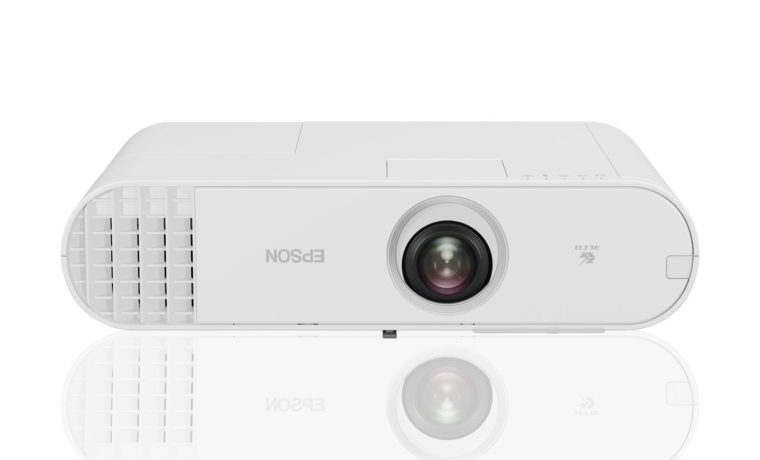
Epson PowerLite U50 Education Projector Review
The Epson PowerLite U50 Education Projector is designed for classrooms, conference rooms, and small auditoriums. With 3,700 lumens brightness and WUXGA resolution, it delivers sharp and colorful images even in bright spaces. Lightweight and reliable, it’s a strong choice for schools and businesses looking for both quality and flexibility.
Epson PowerLite U50 Specs
Price: $1,149
Resolution: WUXGA (1920 × 1200)
Technology: 3LCD
Brightness: 3,700 lumens
Light Source: Lamp
Lamp Life: 10,000 hours (normal) / 17,000 hours (eco mode)
Weight: 6.83 lbs
Warranty: 2 years parts and labor, 90 days on lamp
👉 For more projector comparisons, see our Education Projector Buyer’s Guide.
Projector Overview
The Epson PowerLite U50 uses 3LCD technology, ensuring colors look just as bright as whites. Unlike many DLP projectors, it avoids color imbalance, making visuals more vivid in classrooms and meeting rooms. With a long lamp life and a lightweight design, it’s easy to maintain and set up.
Key Features
1. Bright and Clear Visuals
With 3,700 lumens, the U50 handles well-lit classrooms without losing clarity. Its WUXGA resolution gives detailed widescreen images, perfect for presentations, videos, and educational content.
2. Advanced Networking
Sends email alerts for troubleshooting.
Supports SNMP for easy network monitoring.
Allows remote control through a web browser.
Compatible with Crestron, AMX, and PJ Link systems.
3. Wireless Sharing
Using Epson iProjection, up to 50 devices—including Chromebooks, smartphones, and laptops—can connect at the same time. The projector can also display content from four devices simultaneously, making collaboration simple.
4. Easy Maintenance
Both the lamp and air filter last up to 10,000 hours, reducing the need for frequent replacements and lowering operating costs.
Who Should Use It?
Education: The U50 is a perfect classroom projector for K-12 and higher education. It includes a built-in speaker for everyday lessons, though larger spaces may need an external system.
Business: For boardrooms and trade shows, it provides sharp, bright images that keep presentations engaging.
👉 Looking for more interactive models? Check the Epson Brightlink 1485Fi Review.
👉 For another solid classroom option, see the BenQ EW800ST Education Projector.
👉 Visit the official Epson PowerLite U50 page for full specs.
Final Thoughts
The Epson PowerLite U50 Education Projector combines brightness, resolution, and easy networking in one affordable package. It works well for both schools and businesses, making it a smart choice for anyone who needs reliable performance in different environments.
NEC MC372X
NEC MC372X Education Projector Review
The NEC MC372X Education Projector is a budget-friendly 3LCD model designed for classrooms and small meeting spaces. With XGA resolution and 3,700 lumens brightness, it provides clear images that stand out even in bright rooms. Compact, easy to set up, and reliable, it’s one of the most affordable education projectors available today.
NEC MC372X Specs
Price: Around $509
Resolution: XGA (1024 × 768)
Technology: 3LCD
Brightness: 3,700 lumens
Contrast Ratio: 16,000:1 dynamic
Zoom Lens: 1.2x manual zoom
Inputs: HDMI (supports 4K@30P), USB, LAN
Lamp Life: Up to 15,000 hours (eco mode)
Weight: Lightweight and portable
👉 For more affordable models, see our Education Projector Buyer’s Guide.
Projector Overview
The NEC MC372X uses 3LCD technology, which makes colors brighter and more accurate compared to many DLP projectors. Its dynamic 16,000:1 contrast ratio ensures better image depth, which helps when showing text or detailed graphics in the classroom. Thanks to its compact size, it’s easy to carry and install in different rooms.
Key Features
1. Advanced Keystone Correction
Teachers and presenters can adjust vertical, horizontal, pincushion, and cornerstone distortions, ensuring the image looks perfect even when the projector is not centered.
2. Network Projection
With the NEC MultiPresenter app (Windows, Mac, iOS, Android), you can wirelessly share screens, photos, documents, and even live camera feeds. The app also allows annotation and on-screen pointing, making lessons more interactive.
3. USB Image Viewer
The MC372X can display JPEG and PNG images directly from a USB stick. You can also run simple slideshows without needing a connected computer, saving time during class.
Who Is It For?
The NEC MC372X is NEC’s most affordable education projector, making it a strong choice for schools on a budget. At around $509, it combines solid brightness, long lamp life, and modern features like wireless screen sharing. This balance of price and performance makes it ideal for classrooms, training rooms, or small meeting spaces.
👉 Looking for more advanced features? Check the Epson PowerLite U50 Education Projector for higher resolution.
👉 For short-throw classrooms, see the BenQ EW800ST Review.
👉 Visit the official NEC Display Solutions page for full specifications.
Final Thoughts
The NEC MC372X Education Projector is a practical and affordable option for schools. It offers bright images, strong networking tools, and flexible installation at a price that works for tight education budgets. For teachers and administrators looking for a reliable classroom projector, the MC372X is an excellent pick.
NEC MC382W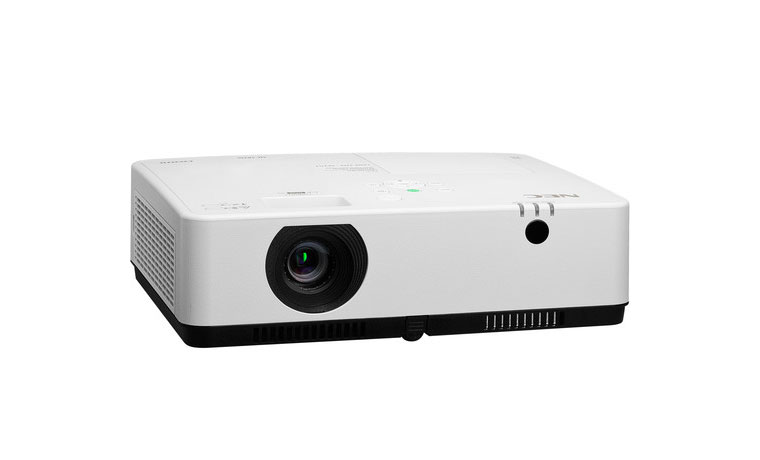
NEC MC382W Education Projector Review | Affordable Classroom Solution
The NEC MC382W Education Projector is a budget-friendly 3LCD model with WXGA resolution (1280×800) and 3,800 lumens of brightness. Priced at around $999 but often available for $599, it delivers excellent value for K-12 classrooms and training spaces.
Why the NEC MC382W Stands Out
1. Great Price and Performance
The MC382W combines strong brightness with good color accuracy at a very competitive price. It doesn’t aim to replace high-end laser models, but it outperforms most projectors in its range.
👉 Compare with the Epson PowerLite U50 Education Projector if you need higher WUXGA resolution.
2. Standard Throw with Networking
This projector uses a standard throw lens, making it easy to place in classrooms. It includes wired networking and supports wireless connectivity with an optional module. While it lacks HDBaseT, that’s rarely required in typical school setups.
👉 For wireless-focused classrooms, see the BenQ EW800ST Education Projector.
3. Screen Mirroring
The NEC MultiPresenter app allows up to 16 devices to connect and mirror content. With the wireless module, students and teachers can share their screens at the same time. For wired connections, one device can present at a time. This feature supports collaborative and interactive teaching.
4. 4K Input Support
Although the MC382W’s native resolution is WXGA, it accepts 4K input signals. NEC has also promised updates for better 4K handling in the future. While not essential, it adds value for classrooms that want future-proof options.
5. PC-Free Presenting
Teachers can show JPEG files directly from a USB drive, thanks to the built-in media player. This makes quick lessons or presentations possible without needing a laptop.
A Small Drawback
The projector’s 1.2:1 zoom ratio gives only limited placement flexibility. You need to position it about 1.5 to 2 feet from the screen. For most classrooms, this is manageable, but it’s worth noting before installation.
Summary
The NEC MC382W Education Projector strikes the right balance between performance and price. It provides strong brightness, useful networking tools, and classroom-ready collaboration features. At around $599 on sale, it’s one of the best values in the education market.
It even won the Best in Classroom Price Performance Award, proving why it’s a popular choice among schools.
👉 Learn more from the official NEC Display Solutions page.
👉 For more top picks, visit our Education Projector Buyer’s Guide.
OPTOMA EH330UST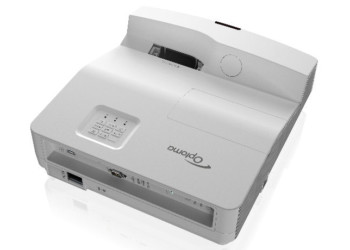
Optoma EH330UST Education Projector Review | Ultra-Short Throw Solution
The Optoma EH330UST Education Projector is a 3,600-lumen ultra-short throw model designed for schools and business environments. It produces a sharp 100-inch image from just a few inches away, making it ideal for wall-mounted setups in classrooms. With a native 1080p resolution (1920×1080) and support for WUXGA (1920×1200), it delivers clear, detailed visuals.
Key Features of the Optoma EH330UST
1. Wireless Options
The projector supports wireless screen mirroring when paired with the optional HDCast Pro module (around $80). Teachers and students can easily mirror content from Android, Windows, Mac, and mobile devices, making classroom collaboration smoother.
👉 Compare with the BenQ EW800ST Education Projector if you need built-in wireless features.
2. Advanced Networking
With its LAN port and support for systems like Crestron RoomView and PJLink, the EH330UST allows administrators to control multiple projectors from one platform. This is perfect for schools and offices with many classrooms or meeting rooms.
👉 For network-focused models, check the Epson PowerLite U50 Education Projector.
3. PC-Free Presenting
The EH330UST makes presentations simple. Just connect a USB drive to display photos, documents, or Microsoft Office files (Word, Excel, PowerPoint) without using a computer. This feature saves time for teachers and presenters.
Summary
The Optoma EH330UST Education Projector offers a bright picture, flexible installation, and easy content sharing. Its ultra-short throw design is perfect for classrooms where space is limited. With optional wireless mirroring, advanced networking, and PC-free presenting, it delivers real value for modern education and business settings.
👉 Learn more on the Optoma Official Website.
👉 Explore our full Education Projector Buyer’s Guide for more classroom-ready models.
Higher Education Projectors
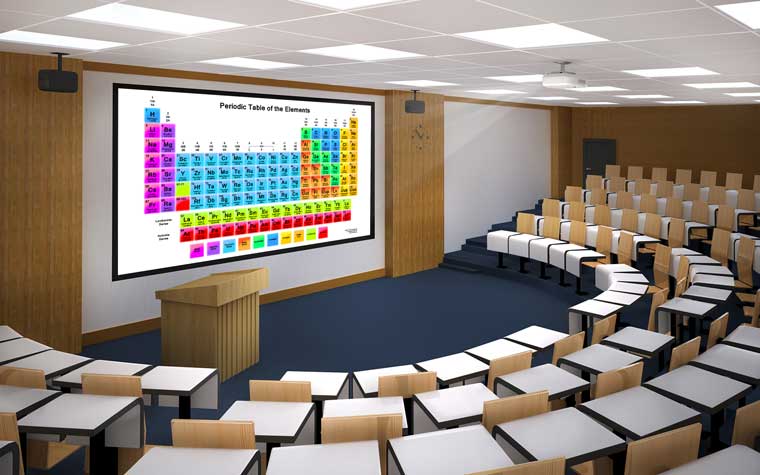
Projectors in the Higher Education category are usually brighter and fixed in place. They work well in university classrooms, lecture halls, auditoriums, and large K-12 multi-purpose rooms. These projectors often offer several lens options to fit different needs.
BENQ LU710
BenQ LU710 Education Projector Review | Bright 4,000-Lumen Laser Solution
The BenQ LU710 Education Projector delivers 4,000 lumens brightness and a sharp WUXGA resolution (1920 × 1200). Built with DLP technology and BenQ’s BlueCore laser engine, it produces vibrant colors with 92% Rec.709 coverage. With a dynamic contrast ratio of 3,000,000:1 and up to 20,000 hours of laser life, this projector offers long-lasting performance for classrooms and meeting spaces.
Key Features of the BenQ LU710
1. Laser Light Engine
The LU710 uses a sealed laser and phosphor system that is IP5X dust-resistant. This design reduces maintenance and ensures reliable use for many years. It also powers on quickly, cutting wait times compared to traditional lamp projectors.
👉 For another reliable laser model, check the Epson BrightLink 1485Fi Education Projector.
2. Wireless Projection
With accessories like the QCast Mirror dongle or BenQ InstaShow, the LU710 supports wireless screen sharing. Teachers and students can easily present from laptops, tablets, or phones without extra apps or drivers.
👉 Compare with the BenQ EW800ST Education Projector for built-in wireless teaching tools.
3. Auto Keystone Correction
The projector offers ±30° vertical and horizontal keystone correction. This ensures a clear, straight image even if the projector is not perfectly centered.
4. Network Control & Management
Schools and businesses can manage the LU710 over a LAN network. Using BenQ’s Multiple Display Administrator software, IT teams can monitor, update, and control multiple projectors at once. It also supports Crestron, AMX, and PJ-Link for wider compatibility.
👉 For large institutions, the Epson PowerLite U50 Education Projector is another great option with advanced networking.
Summary
The BenQ LU710 Education Projector combines bright laser performance, strong color accuracy, and smart wireless options. Its low-maintenance design and powerful networking features make it an excellent choice for classrooms, lecture halls, and modern conference rooms.
👉 Learn more on the BenQ Official Website.
👉 Explore our Education Projector Buyer’s Guide for more classroom-ready solutions.
Maxell MP-JU4001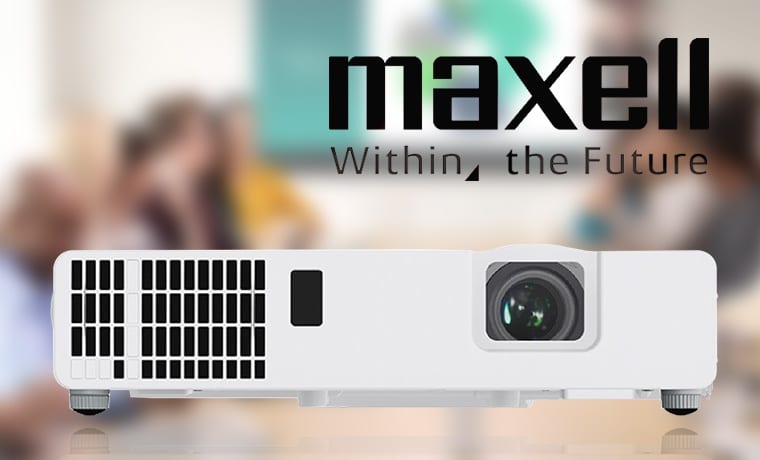
Maxell MP-JU4001 Education Projector Review | Reliable 4,000-Lumen 3LCD Solution
The Maxell MP-JU4001 Education Projector is a 3LCD laser projector built for classrooms, meeting rooms, and mid-sized conference spaces. With 4,000 lumens of brightness and WUXGA resolution (1920 × 1200), it delivers sharp, vibrant images. Its low-maintenance laser light source makes it a strong choice for schools and businesses looking for reliability.
Key Features of the Maxell MP-JU4001
1. Laser Light Engine
The projector uses a ceramic phosphor chip for stable performance and quieter operation. The laser source lasts up to 20,000 hours, reducing the need for replacements.
👉 Compare with the BenQ LU710 Education Projector, another long-life laser model.
2. Bright and Vivid Colors
Thanks to 3LCD technology, the MP-JU4001 delivers equal color and white brightness. This ensures clear, lifelike images even in bright classrooms or meeting halls.
👉 For another vibrant 3LCD option, check the Epson PowerLite U50 Education Projector.
3. Content Over IP
Teachers and presenters can connect laptops or mobile devices over the network to share content wirelessly. This feature improves classroom collaboration and meeting efficiency.
4. Network Management
Schools can control multiple projectors through a LAN. The MP-JU4001 supports Crestron, AMX, and PJ-Link for seamless integration with existing systems.
5. DICOM Simulation Mode
With DICOM simulation, the projector displays medical images like X-rays with clarity. This makes it a strong choice for medical schools and training programs.
6. Image Adjustment Tools
The Perfect Fit 2 feature allows precise corner and side adjustments. Together with HDCR (High Dynamic Contrast Range) and Accentualizer, it enhances sharpness and detail, even in bright rooms.
👉 See how it compares to the Optoma EH330UST Education Projector for short-throw classrooms.
Summary
The Maxell MP-JU4001 Education Projector combines strong color performance, advanced image correction, and a reliable laser engine. At under $2,000, it offers excellent value for schools, meeting rooms, and training environments.
👉 Learn more at the Maxell Official Website.
👉 Explore our full Education Projector Buyer’s Guide for more classroom-ready solutions.
LG BU50NST
LG BU50NST Education Projector Review | 4K UHD with 5,000 Lumens
The LG BU50NST Education Projector is a compact yet powerful model built for classrooms, meeting rooms, hospitals, and museums. With 4K UHD resolution (3840 × 2160) and 5,000 lumens brightness, it delivers crisp, bright images in almost any environment. Its laser light engine lasts up to 20,000 hours, making it a low-maintenance, long-term solution.
Key Features of the LG BU50NST
1. Laser Light Engine
The BU50NST uses DLP with laser/phosphor technology, producing sharp images and stable brightness. The 20,000-hour light source ensures reliable use without frequent replacements.
👉 Compare with the BenQ LU710 Education Projector, another strong laser model for classrooms.
2. 4K UHD Resolution
Thanks to XPR technology, this projector shows detailed 4K content that looks clear and professional. It works well for corporate presentations, classrooms, and medical training where sharp visuals matter.
👉 See how it stacks up against the Epson BrightLink 1485Fi Education Projector.
3. Flexible Installation
The BU50NST includes 1.6x zoom, horizontal and vertical lens shift, and 12-point warping. These tools let you fine-tune the image for perfect alignment without distortion, making installation easier in different spaces.
4. Smart Features with WebOS
The projector runs LG WebOS, giving you access to apps, browsers, and wireless features. It supports Miracast® for screen mirroring, Wi-Fi for content sharing, and Bluetooth audio for connecting to wireless speakers.
5. DICOM Simulation Mode
For medical schools and training centers, the DICOM simulation setting enhances black-and-white images like X-rays, making details clearer during lessons or research.
6. Strong Connectivity
With USB input and HDBaseT support, the BU50NST can send 4K video signals over long distances using a single CAT6 cable. This makes it ideal for larger classrooms, auditoriums, or museums.
Summary
The LG BU50NST Education Projector combines 4K UHD clarity, high brightness, flexible installation, and smart wireless tools. It’s an excellent choice for schools, corporate settings, and medical training environments. With its 20,000-hour laser light engine, you get long-lasting performance with minimal maintenance.
👉 Learn more on the LG Official Website.
👉 Explore our full Education Projector Buyer’s Guide for more classroom-ready options.
NEC P506QL
NEC P506QL Education Projector Review | 4K Laser with 5,000 Lumens
The NEC P506QL Education Projector is a versatile 4K laser model designed for classrooms, museums, and conference rooms. With 5,000 lumens brightness and a 20,000-hour laser light source, it delivers sharp, reliable images while keeping maintenance costs low. Priced around $4,299, it offers strong value for schools and institutions looking for long-term projection solutions.
Key Features of the NEC P506QL
1. True-to-Life 4K Resolution
This projector uses DLP technology with pixel shifting to produce detailed 4K images. The visuals are crisp, making it perfect for educational presentations, training, and museum exhibits.
👉 Compare with the LG BU50NST Education Projector, another 4K laser model with smart features.
2. Long-Lasting Laser Light Engine
With 5,000 lumens brightness and a phosphor laser wheel, the NEC P506QL delivers vivid images in bright classrooms or lecture halls. Its 20,000-hour lifespan means no lamp replacements, reducing downtime and cost.
👉 Learn more about why laser projectors are leading modern classrooms in our Education Projector Buyer’s Guide.
3. Advanced Connectivity
The projector includes:
Two HDMI ports for modern devices
HDBaseT for long-distance video and audio over CAT5e/CAT6 cables (up to 328 feet)
USB port for powering accessories
LAN port for remote monitoring and control
These connections make it ideal for collaborative learning spaces.
4. Multi-Source Display
You can project up to four 1080p images at once, allowing students or team members to share content simultaneously. This feature enhances collaboration in classrooms and training sessions.
5. Flexible Installation
The NEC P506QL supports manual lens shift, 1.5x zoom, tilt-free and roll-free installation, 360° rotation, and portrait mode. These options make it easy to install in different room sizes and orientations.
6. DICOM Simulation Mode
For medical schools and training centers, the DICOM mode displays X-rays and medical scans with improved contrast and detail, supporting accurate teaching and analysis.
7. Network Management
Using NEC’s NaViSet Administrator 2 software, schools and businesses can manage multiple projectors from a single dashboard. It also works with Crestron, AMX, and PJ Link, making it a reliable choice for IT-managed environments.
Summary
The NEC P506QL Education Projector combines 4K clarity, high brightness, flexible installation, and strong networking tools. It’s built for classrooms, museums, and professional training spaces that need long-lasting performance with minimal maintenance. At around $4,299, it’s a smart investment for institutions that want a future-ready projector.
👉 Visit NEC’s Official Website for more details.
👉 Explore more classroom-ready projectors in our Education Projector Reviews.
MAXELL MP-TW4011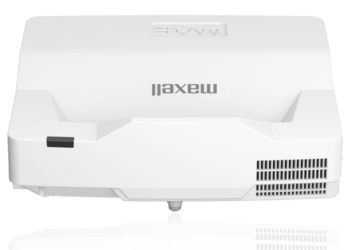
Maxell MP-TW4011 Education Projector Review | Interactive Laser for Classrooms
The Maxell MP-TW4011 Education Projector is built for schools that need a reliable, interactive display solution. With a laser light engine rated for up to 50,000 hours, this model can last decades under normal school use—nearly 46 years if used 6 hours a day during a typical school year.
Key Specs
Resolution: WXGA (1280 × 800), close to 720p
Brightness: 4,200 lumens (claimed), about 2,300 lumens measured in brightest mode
Technology: 3LCD with a laser light source
Weight: 17.4 lbs
Warranty: 5 years parts and labor, plus 20,000 hours on the light source
Why It Works for Schools
The MP-TW4011 fits perfectly into K-12 classrooms:
WXGA resolution provides sharp and clear images for lessons, videos, and presentations.
Interactive features keep students engaged, letting them write, draw, and interact directly with the projection surface.
Wireless support allows teachers to connect and control the projector using a smartphone or tablet through a simple app.
👉 Compare with the Epson BrightLink 1485Fi Education Projector, another top choice for interactive classrooms.
Other Highlights
Ultra-long lifespan: With up to 50,000 hours, schools save money by avoiding frequent lamp or projector replacements.
Bright performance: Works well even in rooms with some ambient light.
Flexible for different spaces: Suitable for small classrooms or larger lecture halls, and two units can be paired for even bigger screens.
👉 Learn more about choosing the right projector brightness in our Education Projector Buyer’s Guide.
Summary
The Maxell MP-TW4011 Education Projector delivers interactive features, long lifespan, and strong brightness for modern classrooms. With its reliability and engagement tools, it’s an excellent investment for schools that want a projector built to last for many years.
👉 Visit Maxell’s Official Projector Page for detailed specifications.
👉 Explore more reviews in our Education Projector section.
OPTOMA ZU506T-W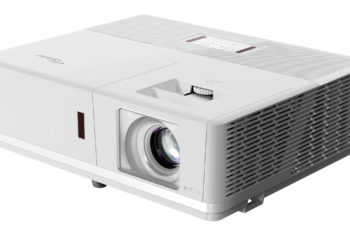
Optoma ZU506T-W Education Projector Review | Bright WUXGA Laser for Schools
The Optoma ZU506T-W Education Projector delivers 5,000 lumens brightness and a sharp WUXGA resolution (1920 × 1200). Designed for classrooms and medical teaching, it displays detailed visuals, making it ideal for showing X-rays, MRIs, and CAT scans. With a compact build and long-lasting laser engine, it balances performance, flexibility, and durability.
Key Specs
Resolution: WUXGA (1920 × 1200)
Brightness: 5,000 lumens (measured at ~4,380 lumens in brightest mode)
Technology: DLP with laser phosphor light source
Light Engine Life: Up to 30,000 hours
Weight: 12.1 lbs
Price: Around $2,799
Warranty: 5 years plus 3-year replacement program
Why It Works for Schools and Medical Training
The Optoma ZU506T-W stands out for its balance of power and flexibility:
Laser phosphor engine delivers bright, rich colors with minimal upkeep.
1.6x zoom lens and 15% lens shift make installation flexible in classrooms and lecture halls.
Wide connectivity, including mic input and HDBaseT support, ensures compatibility with both older and modern devices.
Lightweight design makes it easier to install or relocate compared to bulkier 3LCD projectors.
👉 Compare with the NEC P506QL Education Projector, another popular choice for medical and higher education environments.
Performance Highlights
Unlike many business DLP projectors, the ZU506T-W maintains brightness even in its most color-accurate modes. This makes it perfect for environments where accurate visuals matter, such as classrooms, medical schools, or training centers.
👉 Learn more about selecting the right brightness level in our Education Projector Buyer’s Guide.
Summary
The Optoma ZU506T-W Education Projector combines high brightness, sharp resolution, flexible installation, and strong color accuracy. With a 30,000-hour laser light engine and a solid warranty, it’s an excellent choice for schools, universities, and medical training environments looking for a reliable and long-term projection solution.
👉 Visit Optoma’s official site for full technical details.
👉 Explore more Education Projector reviews to find the best fit for your classroom.
PANASONIC PT-VMZ50
Panasonic PT-VMZ50 Education Projector Review | Compact 5,000-Lumen 3LCD Laser
The Panasonic PT-VMZ50 Education Projector combines compact design with powerful performance. With 5,000 lumens brightness and sharp WUXGA resolution (1920 × 1200), it delivers clear and vibrant images for classrooms, lecture halls, and business settings. Weighing just 15.9 lbs, it’s lightweight, easy to install, and portable enough to move between rooms.
Key Specs
Resolution: WUXGA (1920 × 1200)
Brightness: 5,000 lumens (measured at 5,042 lumens)
Technology: 3LCD with laser/phosphor light engine
Light Engine Life: Up to 20,000 hours
Weight: 15.9 lbs
Price: Around $2,499
Why It Works Well for Education
The PT-VMZ50 was designed with schools and universities in mind:
Portable design makes it easy to share between classrooms or departments.
Digital zoom allows up to 3x enlargement—perfect for displaying maps, technical drawings, or detailed lesson material.
Flexible installation supports portrait mode and angled placement, useful for multipurpose learning spaces.
Wireless connectivity enables screen sharing from laptops, tablets, and smartphones, cutting cable clutter.
4K input support at 30fps gives it future-ready compatibility, even though it’s a WUXGA projector.
Built-in 10W speakers provide clear audio for standard classrooms.
👉 Compare it with the Epson PowerLite U50 Education Projector for a more budget-friendly alternative.
Extra Features
The Panasonic PT-VMZ50 includes several features that enhance everyday use:
HDBaseT for long-distance video, audio, and control signals via a single CAT6 cable.
Quiet operation, making it suitable for lecture halls and libraries.
Media player and built-in browser, supporting PC-free presentations.
👉 Learn more about choosing the right brightness and resolution in our Education Projector Buyer’s Guide.
Summary
The Panasonic PT-VMZ50 Education Projector offers an excellent balance of portability, brightness, and long-term value. With its 5,000-lumen output, wireless connectivity, and future-ready 4K input support, it’s a strong option for schools, universities, and training centers that need reliable and flexible projection.
👉 Visit Panasonic’s official site for detailed specifications.
👉 Explore more Education Projector reviews to compare models before making a purchase.
VIVITEK DH3660Z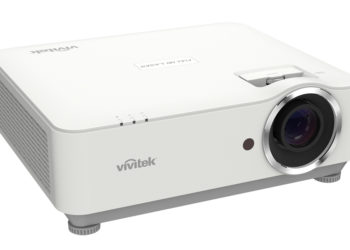
Vivitek DH3660Z Education Projector Review | Bright 4,500-Lumen 1080p Laser
The Vivitek DH3660Z Education Projector is a sharp and powerful 1080p DLP laser projector. With 4,500 lumens of brightness, it’s perfect for classrooms, meeting rooms, and even small auditoriums. It also includes a DICOM simulation mode, making it useful for medical schools and training centers that need to display detailed medical images.
Key Specs
Resolution: Full HD 1080p (1920 × 1080)
Brightness: 4,500 lumens (measured 4,269 lumens)
Technology: DLP with laser light engine
Light Engine Life: Up to 20,000 hours
Weight: 15.4 lbs
Price: Around $2,499
Why It Works Well for Education
The DH3660Z delivers excellent performance in real classrooms and business spaces:
Bright, vivid images from its laser light engine and RGBY color wheel.
Flexible installation with a 1.5x manual zoom, +13% vertical lens shift, and full 360° projection support.
Built-in 10W speaker, powerful enough for standard classrooms.
Quick start with Instant On/Off, powering up in just 3 seconds and auto-selecting the correct input.
Wireless presentation support with Vivitek’s NovoConnect (sold separately), making it easy for teachers and students to share content from laptops, tablets, or phones.
👉 Compare it with the Panasonic PT-VMZ50 Education Projector for another bright and flexible classroom solution.
Extra Features
The DH3660Z is designed to be both practical and user-friendly:
20,000-hour laser light source reduces maintenance and operating costs.
Compact size makes it easy to install in classrooms or move between spaces.
Multiple inputs (HDMI, VGA, USB) support a wide range of teaching and business devices.
👉 Learn more about brightness and classroom screen size in our Education Projector Buyer’s Guide.
Summary
The Vivitek DH3660Z Education Projector combines brightness, reliability, and flexibility. With its laser light engine, easy installation, and wireless options, it’s a strong choice for schools, universities, and training environments. If you want a projector that starts quickly, produces vibrant colors, and supports modern teaching needs, the DH3660Z is a smart investment.
👉 Visit Vivitek’s official site for detailed specifications.
👉 Check out more Education Projector reviews to compare alternatives.
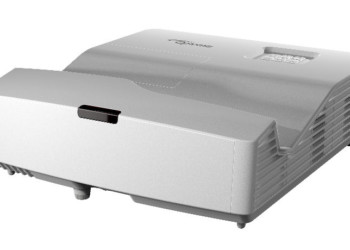
Optoma EH330UST Education Projector Review | Ultra-Short Throw 1080p Solution
The Optoma EH330UST Education Projector is a bright 3,600-lumen DLP model designed for classrooms and business spaces. With its ultra-short throw lens, it can project a 100-inch image from just a few inches away, making it ideal for smaller classrooms or meeting rooms with limited space.
Key Specs
Resolution: Native 1080p (1920 × 1080), supports up to WUXGA (1920 × 1200)
Brightness: 3,600 lumens
Technology: DLP
Wireless Option: HDCast Pro module (sold separately, about $80)
Inputs: HDMI, USB, LAN, VGA
Why It Works in Education
The EH330UST is built for schools and offices that need reliable, flexible projection:
Ultra-short throw means no shadows and less glare—teachers and presenters can stand close without blocking the screen.
Wireless screen mirroring with the optional Optoma HDCast Pro lets students and teachers cast from Android, Windows, Mac, or mobile devices.
Advanced networking support with Crestron RoomView and PJLink makes it easy for IT staff to manage multiple projectors at once.
PC-free media viewing allows presentations of photos and Microsoft Office files directly from a USB drive, saving time in class.
👉 Compare with the Vivitek DH3660Z Education Projector if you want a laser alternative with higher brightness.
Classroom Benefits
Big images in tight spaces: Perfect for wall-mounted setups in classrooms.
Flexible teaching tools: Supports both wired and wireless connections for different devices.
Low maintenance: Lamp life and simple setup reduce downtime for teachers.
Budget-friendly: A strong feature set at a competitive price point.
👉 Learn more about screen size and brightness in our Education Projector Buyer’s Guide.
Summary
The Optoma EH330UST Education Projector offers excellent value for schools and offices. With ultra-short throw convenience, wireless screen sharing, and advanced network management, it supports interactive, modern learning environments. Add its PC-free media player, and you have a flexible projector that makes teaching and collaboration easier.
👉 Visit Optoma’s official site for more details.
👉 Explore more Education Projector reviews to find the best fit for your classroom.
High End/Specialty Projectors

The High-End, Specialty Projectors category features very bright projectors made for big places like large auditoriums, lecture halls, museums, and big churches (mega-churches). These projectors are also used for special purposes like signage and advanced tasks such as edge blending and projection mapping.
EPSON PRO L1755UNL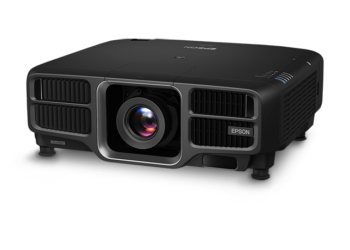
Epson Pro L1755UNL Education Projector Review | Bright 15,000-Lumen Large Venue Solution
The Epson Pro L1755UNL Education Projector is built for large venues that need both brightness and flexibility. With 15,000 lumens and a sharp WUXGA resolution (1920×1200), it handles bright environments while supporting 4K content through pixel-shifting technology.
Part of Epson’s L-Series, this model sits in the middle of the lineup, which ranges from 6,000 to 30,000 lumens. The L1755UNL weighs about 52 pounds (without a lens) and comes in both black and white options, making it suitable for different installations.
Key Features of the Epson Pro L1755UNL
Laser Light Engine: Uses a dual blue-laser system. One laser creates red and yellow with phosphor wheels, while the other delivers blue. A prism then blends these into a bright, vibrant image.
Pixel Shifting Technology: While not native 4K, Epson’s pixel-shifting process sharpens details, giving near-4K clarity when displaying UHD content.
Projection Mapping & Edge Blending: Perfect for creative venues like museums, concerts, or lecture halls. You can map images onto curved or 3D surfaces, or blend multiple projectors for one seamless display. Note that pixel shifting and edge blending cannot run at the same time.
Flexible L-Series Options: With models from 6,000 to 30,000 lumens, schools and businesses can scale up depending on their space size and lighting needs.
👉 Compare with the Epson BrightLink 1485Fi Education Projector if you need an interactive classroom model instead of a large-venue solution.
Why It Works for Education
For universities, auditoriums, and museums, the Epson Pro L1755UNL offers:
Massive, sharp images even in large lecture halls or well-lit rooms.
Creative projection tools like mapping and edge blending to support immersive learning and exhibits.
Long-lasting laser light engine (up to 20,000 hours) that reduces maintenance costs for schools.
👉 Learn more about choosing the right model in our Education Projector Buyer’s Guide.
Summary
The Epson Pro L1755UNL Education Projector is a powerful choice for schools, museums, and event spaces that need bright, sharp visuals with advanced display features. With its laser light engine, pixel-shifting technology, and projection mapping tools, it’s designed for institutions that want more than just a standard classroom projector.
👉 Visit Epson’s official website for full specs.
👉 Explore more large-venue Education Projectors to find the best fit for your space.
NEC PX1005QL
NEC PX1005QL Education Projector Review | Native 4K Power for Large Venues
The NEC PX1005QL Education Projector is a professional-grade 4K DLP projector designed for large venues such as schools, universities, businesses, and houses of worship. With 10,000 lumens of brightness and a native 4K resolution (3840×2160), it delivers sharp, detailed images that outperform many pixel-shifting projectors.
Priced at around $24,000, the PX1005QL is more affordable than many 4K 3LCD projectors with similar brightness. Its laser light engine lasts up to 20,000 hours, reducing maintenance and ensuring long-term reliability.
Key Features of the NEC PX1005QL
Interchangeable Lenses: Choose from 8 lens options, making it possible to project from both short and long distances. With 10 lens memory settings, switching setups is fast and easy.
Edge Blending & Projection Warping: Corrects image distortion on curved or irregular surfaces. Multiple projectors can blend images into one seamless display, ideal for large classrooms or auditoriums.
Extensive Connectivity: Includes two DVI-D ports, two HDMI 2.0b inputs, an HDBaseT port, and four 3G-SDI inputs for professional video workflows. Perfect for institutions needing flexible setups.
Laser Light Engine: Delivers up to 20,000 hours of performance with minimal upkeep, lowering long-term costs for schools and businesses.
👉 Compare with the NEC P506QL Education Projector if you want a lower-cost option with flexible installation features.
Why It Works for Education
The NEC PX1005QL Education Projector is ideal for:
Large lecture halls needing crisp, detailed 4K images.
Universities and training centers that require long-lasting, low-maintenance projectors.
Museums or event spaces that need advanced projection mapping and edge blending.
👉 For more classroom-focused options, check out our Education Projector Buyer’s Guide.
Summary
The NEC PX1005QL Education Projector combines native 4K clarity, 10,000 lumens brightness, and professional installation features like interchangeable lenses and advanced image correction. It’s a smart investment for schools, universities, and organizations that want reliable, top-tier performance in large spaces.
👉 Learn more from NEC’s official website.
👉 Explore more large-venue Education Projectors to compare models.
PANASONIC PT-MZ16/BU
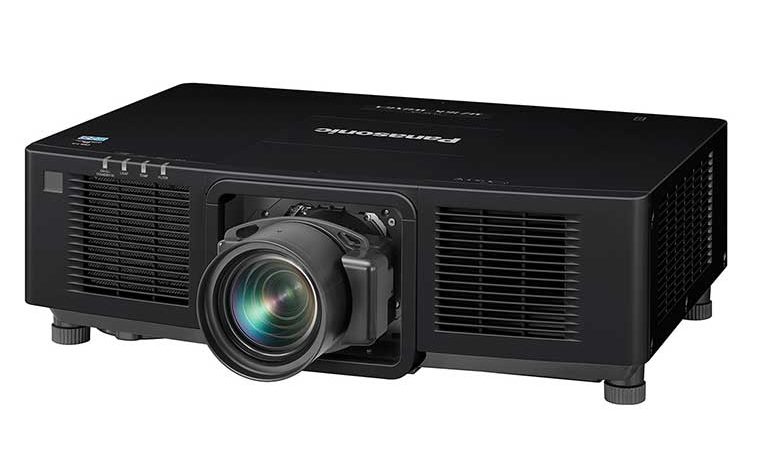
Panasonic PT-MZ16KL Education Projector Review | Ultra-Bright for Large Venues
The Panasonic PT-MZ16KL Education Projector is built for lecture halls, museums, and other large venues that demand power and precision. With WUXGA resolution (1920×1200) and 3LCD laser technology, it delivers sharp, vibrant images while keeping maintenance low. Its laser light engine lasts up to 20,000 hours, making it reliable for long-term use.
Key Features of the Panasonic PT-MZ16KL
Ultra-Bright Performance: Delivers 16,000 lumens, bright enough for rooms with high ambient light.
Compact Design: Despite its power, it remains lightweight and compact, making setup easier.
Flexible Lens Options: Offers seven interchangeable lenses from short throw to zoom, giving installation flexibility.
Modern Connectivity: Includes DVI-D, HDMI 2.0b, HDBaseT, and 3G-SDI ports, covering both current and professional AV needs.
Multi-Laser Engine: Uses multiple diodes. If one fails, the projector continues running at nearly full brightness, ensuring reliability.
Edge Blending & Warping: Supports projection on curved surfaces and lets multiple units create one seamless large display.
Smart Info Monitor: A small rear display shows temperature, runtime, and error alerts, making maintenance simple.
👉 Compare with the NEC PX1005QL Education Projector if you need a native 4K alternative.
Why It Works for Education
The Panasonic PT-MZ16KL Education Projector is perfect for:
Universities and lecture halls that need bright, sharp images even in large, well-lit rooms.
Museums and training centers where advanced projection mapping creates immersive displays.
Schools and auditoriums requiring reliable, long-lasting performance with minimal downtime.
👉 For more options, check out our Education Projector Buyer’s Guide.
Summary
The Panasonic PT-MZ16KL Education Projector stands out with 16,000 lumens brightness, flexible lens choices, and reliable multi-laser technology. Its compact design, professional connectivity, and advanced blending features make it a top choice for large spaces that demand premium performance.
👉 Learn more on Panasonic’s official site.
👉 See more large venue Education Projectors for comparisons.
